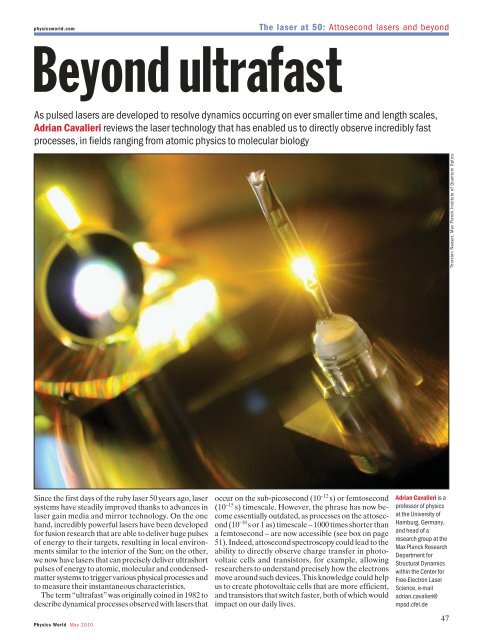special issue
special issue
special issue
You also want an ePaper? Increase the reach of your titles
YUMPU automatically turns print PDFs into web optimized ePapers that Google loves.
physicsworld.comThe laser at 50: Attosecond lasers and beyondBeyond ultrafastAs pulsed lasers are developed to resolve dynamics occurring on ever smaller time and length scales,Adrian Cavalieri reviews the laser technology that has enabled us to directly observe incredibly fastprocesses, in fields ranging from atomic physics to molecular biologyThorsten Naeser, Max Planck Institute of Quantum OpticsSince the first days of the ruby laser 50 years ago, lasersystems have steadily improved thanks to advances inlaser gain media and mirror technology. On the onehand, incredibly powerful lasers have been developedfor fusion research that are able to deliver huge pulsesof energy to their targets, resulting in local environmentssimilar to the interior of the Sun; on the other,we now have lasers that can precisely deliver ultrashortpulses of energy to atomic, molecular and condensedmattersystems to trigger various physical processes andto measure their instantaneous characteristics.The term “ultrafast” was originally coined in 1982 todescribe dynamical processes observed with lasers thatPhysics World May 2010occur on the sub-picosecond (10 –12 s) or femto second(10 –15 s) timescale. However, the phrase has now be -come essentially outdated, as processes on the attosecond(10 –18 s or 1 as) timescale – 1000 times shorter thana fem tosecond – are now accessible (see box on page51). Indeed, attosecond spectroscopy could lead to theability to directly observe charge transfer in photovoltaiccells and transistors, for example, allowingresearchers to understand precisely how the electronsmove around such devices. This knowledge could helpus to create photovoltaic cells that are more efficient,and transistors that switch faster, both of which wouldimpact on our daily lives.Adrian Cavalieri is aprofessor of physicsat the University ofHamburg, Germany,and head of aresearch group at theMax Planck ResearchDepartment forStructural Dynamicswithin the Center forFree-Electron LaserScience, e-mailadrian.cavalieri@mpsd.cfel.de47



